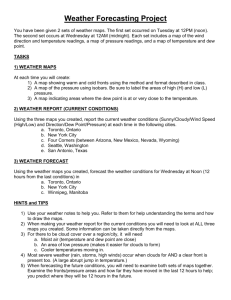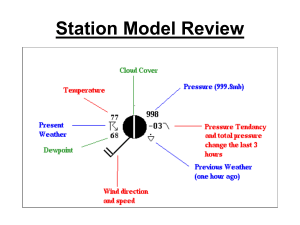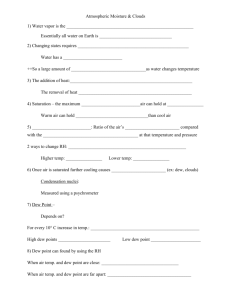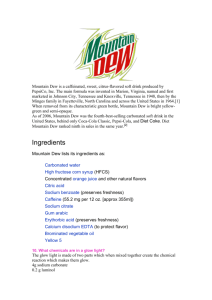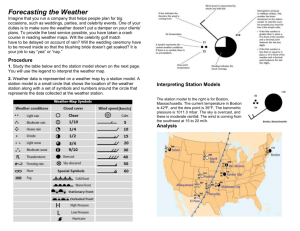DEW RECORDING GAGE Merle
advertisement
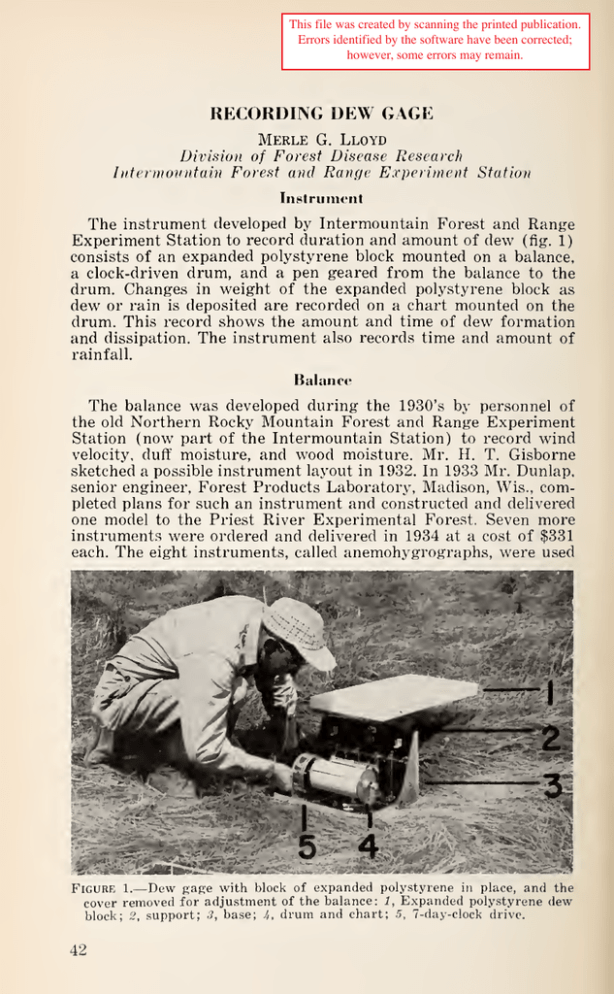
This file was created by scanning the printed publication. Errors identified by the software have been corrected; however, some errors may remain. RECORDING DEW GAGE Merle G. Lloyd Division of Forest Disease Research 1 titer mountain Forest and Range Experiment Station Instrument The instrument developed by Intermountain Forest and Range Experiment Station to record duration and amount of dew (fig. 1) consists of an expanded polystyrene block mounted on a balance, a clock-driven drum, and a pen geared from the balance to the drum. Changes in weight of the expanded polystyrene block as dew or rain is deposited are recorded on a chart mounted on the drum. This record shows the amount and time of dew formation and dissipation. The instrument also records time and amount of rainfall. Balance The balance was developed during the 1930's by personnel of the old Northern Rocky Mountain Forest and Range Experiment Station (now part of the Intermountain Station) to record wind velocity, duff moisture, and wood moisture. Mr. H. T. Gisborne sketched a possible instrument layout in 1932. In 1933 Mr. Dunlap, senior engineer, Forest Products Laboratory, Madison, Wis., completed plans for such an instrument and constructed and delivered one model to the Priest River Experimental Forest. Seven more instruments were ordered and delivered in 1934 at a cost of $331 each. The eight instruments, called anemohygrographs, were used — 1. Dew gage with block of expanded polystyrene in place, and the cover removed for adjustment of the balance: 1, Expanded polystyrene dew drum and chart; .5, 7-day-clock drive. block; 2, support; 3, base; Figure 42 FIRE CONTROL NOTES 43 with modifications in forest tire research through 1940. Wartime restrictions prevented their production and none have been produced since. The original eight units are now at the Northern Forest Fire Laboratory, Missoula, Mont. Dew Block To measure dew, the fuel moisture sticks originally used on the anemohygrographs were replaced by blocks of expanded polystyrene. The duff moisture indicator and wind recorder, with their pens, were removed. Expanded polystyrene is nonhygroscopic and relatively stable when exposed to weather. This inexpensive maused commercially as insulation, is readily available in by 12 by 108 inches at $2.50 each. One sheet contains enough material to make three dew blocks. Hirst in England used expanded polystyrene to measure duration of leaf wetness. He found that a block of polystyrene became wet and dry at almost the same time as the leaves of the crop he was studying. The dew blocks for this instrument are each IV2 by 12 by 24 inches. They are suspended at three points on the balance. Two points are pivoted at the ends of a T-shaped support that acts as a fulcrum. The remaining suspension point at the other end of the block is connected through pivots and counterweights to a pen. The pen records changes in weight of the dew block on a chart mounted on the 7-day clock-driven drum. The blocks weigh approximately 225 grams, and the frames for their support weigh 75 grams. Dew deposit ranged to as high as 68 grams during a summer night in 1958. Tables were constructed to convert grams of moisture deposited to equivalent fractions of an inch of precipitation. For dew blocks of the surface area used on this instrument, 5 grams of dew would equal approximately 0.001 inch of precipiterial, sheets 1 1 •_> 1 tation. Calibration The gages are calibrated by placing successive 5-gram weights at the center of the dew block and marking the deflection of the pen arm on the chart. The variable weights of the counterbalance make it possible to adjust the gage to a zero mark. Operation Since the gages are light in weight and the drum is clock driven, the instruments are portable and excellent for field use. The dew block is 12 inches above the base of the instrument. Therefore, when the instrument is on the ground, observations are obtained at 1 foot above ground. For observations at other heights, the instrument can be set on stands mounted on poles. Dew could be recorded at ground elevation by placing the instrument in a 1-foot with the dew block at ground level. Apparently, polystyrene has radiational characteristics similar to those of leaf surfaces. A brief test with two gages, one dew block exposed normally and the other covered with green leaves, yielded similar deposits of pit 1 Hirst, J. M. 6: 57-fil. 1957. A simplified surface-wetness recorder. Plant Pathology FIRE CONTROL NOTES 44 dew. The 7-day clock and chart permit recording of dew deposition for extended periods. However, gusty afternoon winds can blow the dew block from its mounting. Best results are obtained in sheltered locations, or when the instruments can be checked daily after the afternoon wind has died down and prior to dew formation. The most dew recorded at the Priest River Experimental Forest during a summer night in 1958 was almost 0.015 inch. Although the instrument also records time and amount of rainfall, amounts greater than 0.020 inch extend the pen arm to its limit. Recorded deposits of rain and dew are easily distinguished; dew is deposited slowly and regularly, but rain causes sudden changes in the trace. Figure 2 shows a typical pen trace during two nights when dew was deposited. — 2. Dew gage at 1030 P.s.t., July 11, 1958. The weight of moisture deposited on the dew block and the equivalent inches of precipitation on the mornings of July 10 and 11 are shown on the chart. Figure
